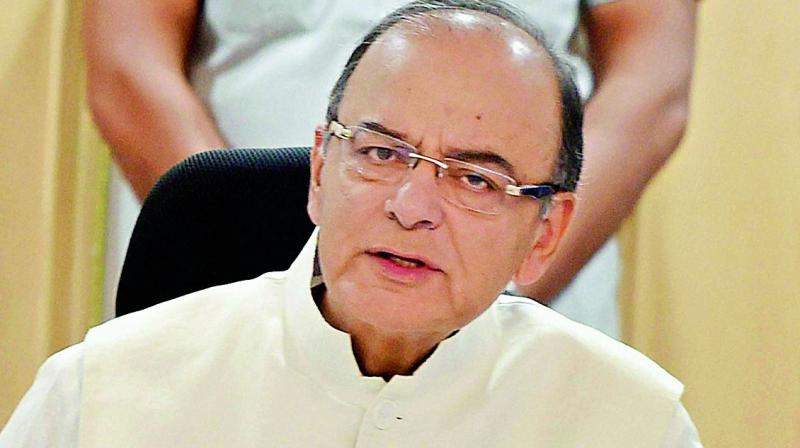GST Council decides on 4-tier tax structure of 5-28 per cent
Lower rate of 5 per cent for essential itmes, two standard rates of 12 and 18 per cent, and highest 28 per cent for luxury goods.

New Delhi: A four-tier GST tax structure of5, 12, 18 and 28 per cent that aims to lower tax incidence on most goods and keep out essential items was decided by a high-powered council today -- a major breakthrough for rollout of the Goods and Services Tax regime from April 1 next year.
Luxury items like high-end cars and demerit goods including tobacco, pan masala and aerated drinks, will be taxed at the highest rate and would also attract a cess in a way that the total incidence of tax remains at almost the current level.
With a view to safeguarding the interest of poor and keeping inflation under check, half the items in CPI basket like foodgrains, would not be taxed at all, while there would be two standard tax rates of 12 and 18 per cent. The lowest rate of 5 per cent would be for common use items under the GST regime targetted to be rolled out from April 1, 2017.
After differences kept away a consensus on the issue at the last meeting, the all-powerful GST Council, headed by Union Finance Minister Arun Jaitley, has decided to impose an additional cess. It would be the difference between the current incidence and the 28 per cent rate, not leading to increase in the final taxation.
Tobacco currently attracts about 65 per cent total tax and for aerated drinks the current rate is about 40 per cent.
Announcing the decisions arrived at the first day of the two-day GST Council meeting, Jaitley said highest tax slab will be applicable to items which are currently taxed at 30-31 per cent (excise duty of 12.5 per cent plus VAT 14.5 pc).
"...finally the consensus is that these items, with cascading effect of 30-31 per cent, will now be taxed at 28 per cent, but with a rider. And the rider is that in this category there are several items which are now being used increasingly by a very large number of people, particularly the lower middle class. So for them 28 or 30 or 31 per cent rate will be higher, and so we are transferring them to 18 per cent," Jaitley told reporters here.
The final list of items for each tax bracket will be worked out by a committee, Jaitley said, adding that soap, oil, shaving stick, toothpaste and such products will likely to move down to 18 per cent bracket.
Chief Economic Advisor Arvind Subramanian said the rate structure "should probably serve to lower inflation...and should probably bring it down."
For most items, GST will be excise duty plus VAT and that incidence will decide on which tax bracket particular goods or items fall into.
Asked about the incidence on automobiles, Jaitley said: "There is a difference between cars and luxury cars. Cars will come under 28 per cent, but luxury cars owners can afford to pay a little more".
Jaitley said Kerala had an alternate opinion on highest tax rate but "all decisions were taken by consensus... We have avoided voting". Higher taxes for compensating states would have been "hugely burdensome for consumers" and the incidence of cess will not add a single rupee to prices, he said.
The collection from this cess as well as that of the clean energy cess would create a revenue pool which would be used for compensating states for any loss of revenue during the first five years of implementation of GST.
The cess would lapse after five years and any surplus to the cess pool at the end of 5 years would be shared between the Centre and states.
Jaitley said about Rs 50,000 crore would be needed to compensate states for loss of revenue from rollout of GST, which is to subsume a host of central and state taxes like excise duty, service tax and VAT, in the first year.
The 4-tier tax structure agreed to is a slight modification over the 6, 12, 18 and 26 per cent slabs proposed, which were discussed at the GST Council last month. The structure agreed to is a compromise to accommodate demand for highest tax rate of 40 per cent by states like Kerala. While the Centre proposed to levy a 4 per cent GST on gold, a final decision was put off, Jaitley said.
Delhi Deputy Chief Minister Manish Sisodia favoured 2 per cent tax on gold, along with some other states. Explaining the tax structure, Jaitley said foodgrains used by common people would be at zero-rate so that the impact of inflationary pressure on them is the least.
The second category of 5 per cent will be on items of mass consumption which are used particularly by common people. The third category of standard rate of 12 and 18 per cent would accommodate most of the goods and services, which too are likely to fall in this bracket.
The fourth slab of 28 per cent would be applicable mainly on white goods, on which the present tax incidence is 30-31 per cent. Those goods used by common man like soap, toothpaste, would be brought in the 18 per cent bracket.
"We are broadly taking it to revenue neutrality and the gains out of this will be set off by narrowing the 28 per cent slab. So you will have lesser items in 28 per cent," he said.

